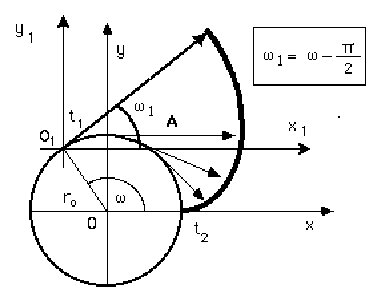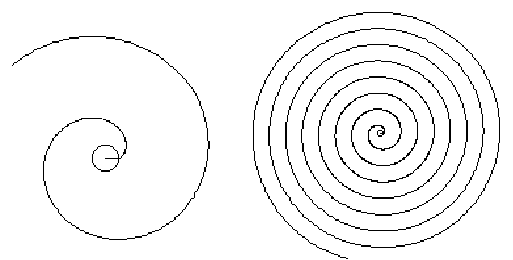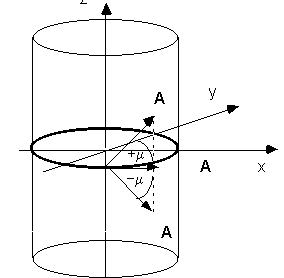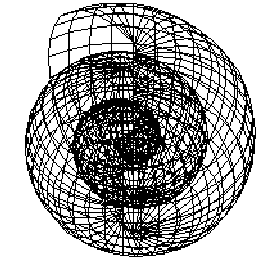|
The wave model of Electron As explained above, the term added to the G.R. can become more and more determining as we experiment with deviations of photons with masses giving out spherical fields of waves composed by waves that are still close to their source of elementary waves. These waves still have a very small radius, and therefore can interact with light, determining the greatest possible angle of deviation for any photons crossing the geometry of the space-time established by their presence. This happens when the relationship between the wavelength of the incident photon and the radius of the resonance orbit crossed by a wave, approaches the unit. In such a case, the first part of the general relativity formula loses importance and can be totally neglected, while the added term becomes predominant: 60)
Letís consider that the angle
of deviation of the photon is greater than the angles normally experimented
in the Compton effect or that it is at least:a =
2p.
61)
Considering the whole wavefront,
which tries to place itself in a resonance condition, only the part that
is closest to the center of the deviant spherical wave field is able to
place itself with one or more elementary surfaces, in the resonance condition.
The diffracted wavefront is deformed, during its propagation, in the Schild space-time, and places itself according to a characteristic surface known as: Sperical Involvent or Spherical Involute. The points intersected by the Spherical Involvent on the plane containing the resonance orbit enable us to describe the plane Involute curve that, according to a x y frame of reference having its origin in the center of the resonance orbit, and to a x1, y1, frame of reference which is parallel to the first one and rotates with the c velocity on the orbit, can be described by: 62) x = r0 [(w + 2kp ) sin w + cos w ] 63) y =r0 [sin w - (w + 2kp ) cos w ]
On the resonance orbit identified by the Involvent, an A vector rotates with an increasing c velocity, going from the t2 to the t1 time describing the E curve appeared in the t1 time. The Involvent produces wavefronts that are more and more approximately circular to the distances compared to which r becomes a negligible quantity, and it maintains the l0 wavelength constant.
It can also be bidimensionally described in an exponential form by the A vector given that: 64) x = x1 + r0 cos w y = y1 + r0 sin w 65)
Fig. 15 We now can tridimensionally deal with the developments of the model, by ideally projecting in the z axis of the resonance orbit the orbit itself, so as to obtain a half positive and half negative infinite ideal cylinder. Z
Fig. 16 Letís consider the set of the A vectors for a fan-shaped direction variation until reaching the ±m angle. 66) -p/4 ³ m ³ +p/4 In order to make the surface
of the Involute spherical we displace the A vector, according to
the temporal properties of the Schild lattice.
Given that l0 = 2pr0, we are able to describe the helicoid as a geodesic, that starting from the resonance orbit twines round the ideal cylinder, which is constituted by the projection of the resonance orbit. Its modulus is given by: 67)
There are two helicoids: one for m that develops from a point of the resonance orbit towards the positive z; the other, that is the mirror image of the first one, develops for m that is propagated towards the negative z. For m = ±p/4 we have:
68) x = r0 cos w1 y = r0 sin w1 ± z = r0 w1 tan m The spherical link of the helicoids with the involvent curve constitutes a surface that, during its evolution, forms the Spherical Involvent.
This is the Spherical Involvent we identify with an elementary particle-rest source of waves, having m0 as a mass. 69) 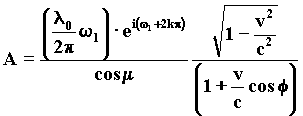
The formula show the secret of the material micro-universe. The wave-particle. As shown in the figure, the meridians appear perpendicular to the plane of the resonance orbit, but in reality (weíll explain it when we speak about the justification of charges), they are inclined and like two screw threads they twine round the spherical surface. A simple Basic program show the structure of the wave-particle: Basic-involvent.htm The first one on the right-hand side and the other one, its mirror image, on the left-hand one (the parallels and meridians don't exist but at the level of the elementary dimensions of the Schild space-time). We now have the data we can use to describe the Spherical Involvent and its dynamics, so as to establish a connection between the behaviour of the particle-source of waves and the relativistic variation of the waves of the Spherical Involvent and identify it with the particle itself.
|

